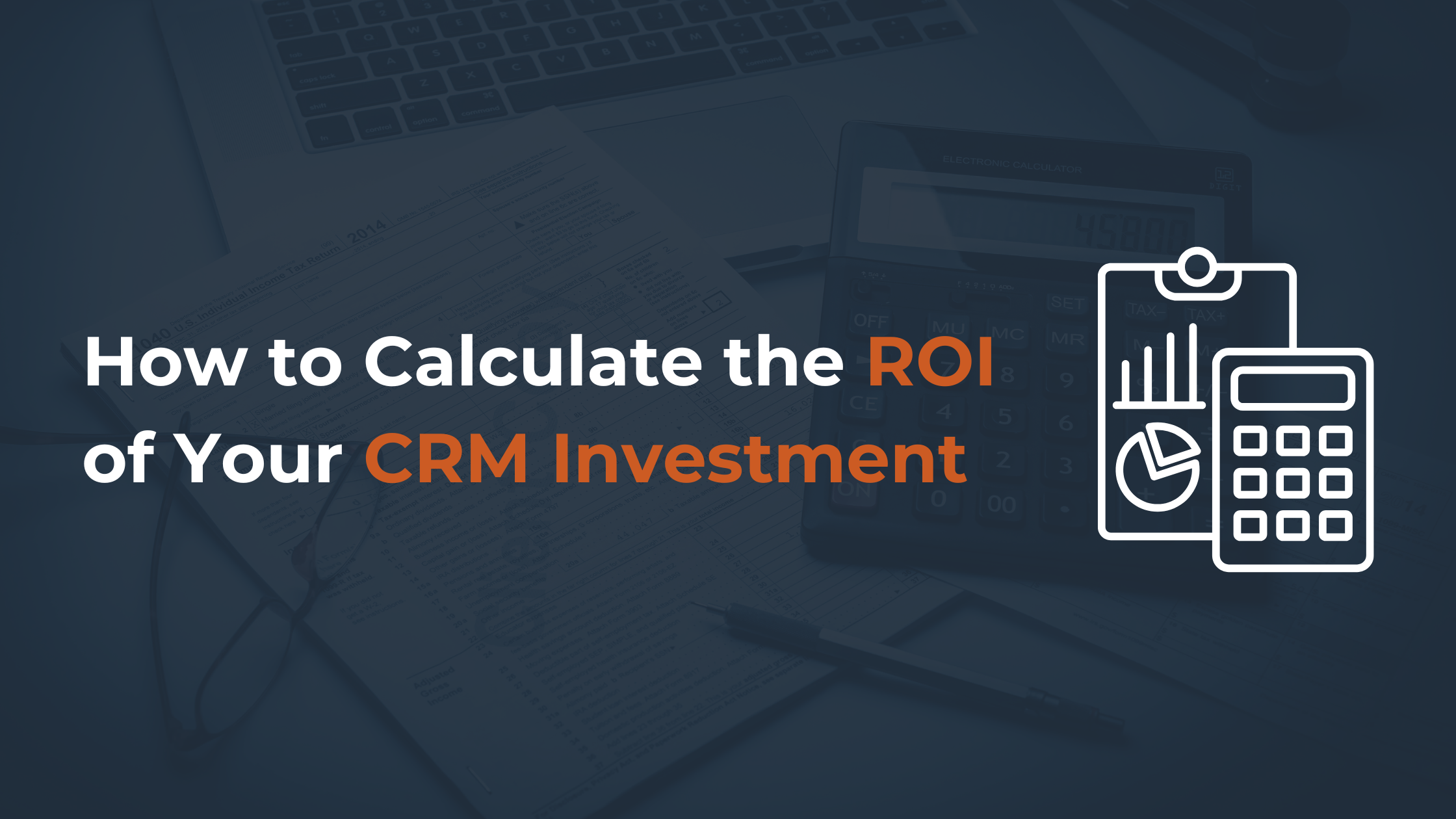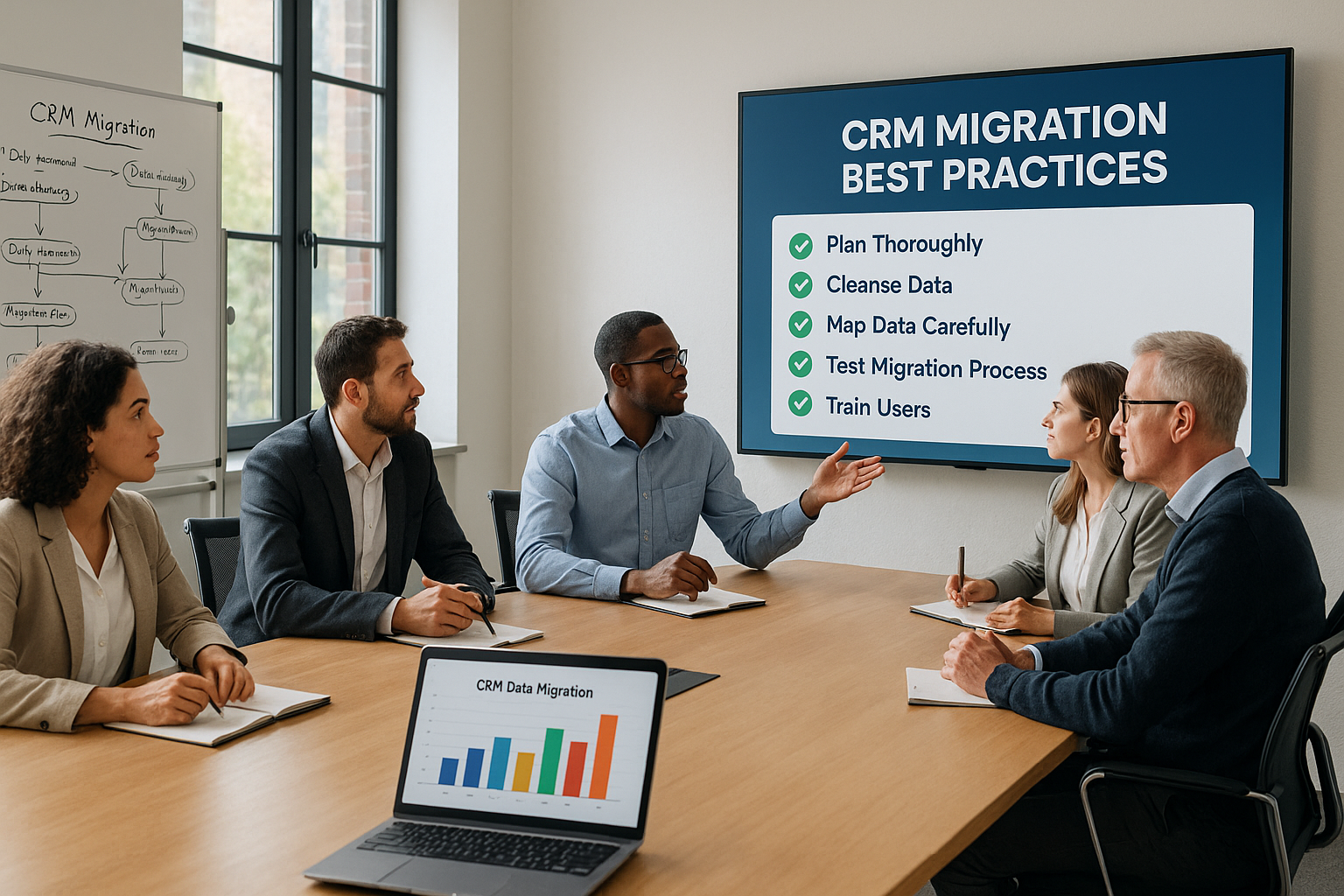Investing in a CRM can lead to serious gains, but only if it’s used effectively. A strong CRM boosts revenue, streamlines sales, and improves customer retention. To measure return on investment, compare the value it brings (like increased sales or time saved) against total costs (software, setup, training).
The formula is simple:
CRM ROI = [(Revenue Gain or Cost Savings – CRM Costs) / CRM Costs] × 100
To maximize ROI, ensure high user adoption, integrate it with your other tools, and track KPIs like lead conversion rates and deal velocity.
Want the full breakdown? Keep reading to learn how to calculate and maximize your CRM ROI.
Table of Content
- What Is CRM ROI and Why It Matters
- Are CRMs Worth the Investment?
- How to Calculate ROI of CRM Tools
- How to Track CRM ROI Over Time
- Factors That Influence CRM Return on Investment
- Evaluate CRM Solutions Based on ROI Potential
- How to Improve ROI in CRM Systems
- ROI for CRM Is a Long-Term Game
- FAQ: CRM Return on Investment

CRM ROI (Customer Relationship Management Return on Investment) is a key metric that measures the financial return a business gets from its investment in a CRM system. In simpler terms, it answers the question: Is the CRM helping us make or save more money than we spend on it?
Why CRM Return on Investment matters:
- Justifies the investment: The costs associated with implementing a CRM, including license, onboarding, training, and possible integrations, can be expensive. Measuring ROI helps leadership understand whether the spend is worth it.
- Highlights business impact: Tracking ROI shows how CRM contributes to your bottom line, whether that’s through increased sales, improved customer retention, streamlined workflows, or reduced manual labor.
- Informs future strategy: A strong CRM ROI signals what’s working, while a weak one can reveal areas that need improvement.
- Supports scaling decisions: If your CRM investment is yielding a high ROI, it’s easier to make the case for scaling the system to other departments, adding automation tools, or investing in advanced features.
Are CRMs Worth the Investment?
Yes, CRMs are often well worth the investment, especially for businesses looking to scale, improve customer relationships, and make data-driven decisions. While the upfront costs of a CRM system can seem high (software fees, implementation, and training), the long-term benefits frequently outweigh those expenses. A well-used CRM increases team productivity, drives more revenue, improves customer retention, and reduces inefficiencies, all of which directly impact ROI.
The right adoption and setup are crucial. Strategic CRM implementation expands the capabilities of a database to include lead nurturing, deal tracking, customer assistance, and upselling.
Common CRM Benefits That Impact ROI
Several core CRM features directly contribute to a positive return on investment:
- Centralized customer data: By keeping all of a customer's interactions, history, and preferences in one location, you can communicate more personally and spend less time looking for information.
- Improved lead management: CRMs help sales teams qualify, prioritize, and nurture leads more effectively, increasing conversion rates.
- Sales pipeline visibility: Real-time tracking of deals and pipeline health supports better forecasting and revenue planning.
- Automation of routine tasks: CRMs automate follow-ups, reminders, and admin tasks, freeing up time for high-value activities.
- Analytics and reporting: Data dashboards reveal what’s working and what’s not, helping businesses make smarter decisions.
- Enhanced collaboration: Teams across departments can access shared customer records, improving communication and continuity.
How CRM Improves Sales, Retention, and Efficiency
CRMs streamline the sales process by organizing contacts, automating outreach, and helping reps stay on top of every deal stage. Sales reps spend more time selling and less time managing spreadsheets, leading to higher close rates.
By tracking customer interactions and behaviors, CRMs support personalized engagement, proactive support, and timely follow-ups that help build loyalty and reduce churn.
CRMs minimize silos, eliminate manual data entry, and integrate with other tools such as calendars, support software, and marketing platforms. This saves time, prevents errors, and improves the overall customer experience.
How to Calculate ROI of CRM Tools

Businesses that know how to calculate the ROI of CRM can streamline operations and comprehend the benefits it offers. It helps justify your CRM spend, guide future investments, and ensure your teams are using the system effectively. A proper ROI calculation compares the revenue gains (or cost savings) generated by the CRM against the total costs of implementing and maintaining it.
CRM ROI Formula: Revenue Gain vs Cost
Here’s the standard formula to calculate CRM Return on Investment:
- CRM ROI (%) = [(Revenue Gain or Cost Savings – CRM Costs) / CRM Costs] × 100
For instance, supposing your CRM cost you $15,000 a year and helped you make $50,000 more in sales:
- CRM ROI = [($50,000 – $15,000) / $15,000] × 100 = 233%
A 233% ROI means you’re making more than double the return on your CRM investment. It`s an excellent outcome.
What to Include in Your ROI CRM Calculation
To justify your tech spend, it’s crucial to know how to track the ROI of CRM before and after implementation. To get a clear picture of your CRM’s impact, factor in both costs and gains.
Include in costs:
- Subscription/license fees
- Onboarding and implementation costs
- Training for staff
- Customization or development work
- Ongoing maintenance and support
Include in gains:
- Increased sales or deal size from better lead tracking
- Higher customer retention and LTV (lifetime value)
- Time saved from task automation and improved workflows
- Fewer errors or missed opportunities
- Reduced support costs due to better customer service
Don't only focus on the numbers; time savings and better customer service are also significant value drivers, but they are more difficult to measure.
Real-World CRM ROI Benchmarks and Case Studies
While every company’s CRM ROI will differ based on use, industry, and adoption, research and case studies offer useful benchmarks that help set expectations and guide investment decisions.
Nucleus Research reports that the average return on CRM investments is $8.71 for every $1 spent. This figure reflects the total economic impact of CRM systems across sectors, factoring in gains from increased sales, improved productivity, better decision-making, and operational cost savings. The report emphasizes that CRM continues to be one of the highest-ROI enterprise software categories, especially when paired with strong adoption and automation.
Salesforce, a leading CRM provider, has shared the following customer-reported benefits based on internal research and global surveys:
- 29% increase in sales revenue, as a result of improved pipeline visibility, deal tracking, and sales automation.
- 34% boost in customer satisfaction, driven by personalized outreach, better support experiences, and centralized customer histories.
- 42% improvement in forecasting accuracy, thanks to real-time dashboards, integrated analytics, and clearer visibility into team performance.
These gains demonstrate how a well-configured CRM can empower sales and support teams to act more effectively and strategically.
How to Track CRM ROI Over Time
Tracking CRM ROI is an ongoing process that helps you continuously evaluate whether your CRM investment is generating value. To track ROI effectively over time, you need clear goals, reliable metrics, and a system for regular performance monitoring.
Key CRM Metrics That Affect ROI
To get a true picture of how your CRM impacts business performance, focus on both revenue-related and efficiency-related metrics. Key metrics to track include:
- Lead Conversion Rate – Are more leads becoming paying customers since CRM adoption?
- Sales Cycle Length – Is the CRM helping you close deals faster?
- Customer Retention Rate – Are customers staying longer thanks to better relationship management?
- Average Deal Size – Has personalized sales outreach increased deal values?
- Revenue per Sales Rep – Are reps more productive with CRM tools?
- Support Ticket Resolution Time – Is customer service becoming more efficient?
- User Adoption Rate – Are your teams actively using the CRM features?
Tracking these KPIs regularly lets you measure the CRM’s impact over time and identify areas for improvement.
Setting Measurable CRM Goals
In order to make ROI tracking useful, you must establish quantifiable objectives that are in line with your company's top priorities. Examples include:
- Increase lead conversion rate by 15% within 6 months
- Reduce manual data entry time by 40%
- Improve customer retention rate by 10% in a year
- Boost cross-sell or upsell revenue by $50,000 annually
- Raise average NPS (Net Promoter Score) by 5 points
Use SMART goals (Specific, Measurable, Achievable, Relevant, Time-Bound) and tie each one to a CRM function or feature, like automation, pipeline visibility, or customer segmentation. This creates accountability and helps tie everyday usage to real business outcomes.
Using Dashboards to Monitor ROI for CRM
Most modern CRMs come with customizable dashboards that allow you to track ROI-related data in real time. These dashboards can include:
- Sales KPIs: Pipeline value, closed deals, conversion rates
- Marketing performance: Email open rates, lead sources, campaign ROI
- Customer support insights: Ticket volume, response time, satisfaction scores
- Productivity data: Activity logs, tasks completed, time saved
Some CRMs also integrate with tools like Google Analytics, accounting software, or business intelligence platforms, enabling you to connect CRM activities to revenue and cost metrics directly.
By creating a dedicated CRM ROI dashboard, you can visualize key metrics and spot trends early. Set up automated reports to keep stakeholders informed and maintain visibility into performance.
Factors That Influence CRM Return on Investment

The price tag or the brand doesn’t just determine the ROI of a CRM; it’s shaped by how well the system is implemented, adopted, and optimized to fit your business needs. While CRM software offers powerful capabilities, the actual return you get depends on how you use it. Several key factors can significantly influence whether your CRM becomes a revenue-generating system or an underused tool.
User Adoption and Training
A CRM can only be as successful as its users. High user adoption is one of the most critical factors in maximizing ROI in CRM. If your team doesn't embrace the platform or only uses a fraction of its features, you won't get the full value from your investment.
Effective onboarding and ongoing training ensure that users understand not just how to navigate the system, but how to apply it to their daily workflows. Training should be tailored to different roles, so that each team can leverage the CRM in ways that directly support their goals.
Integration with Existing Systems
Another major influence on CRM ROI is how well the platform integrates with the rest of your tech stack. CRMs that connect seamlessly with tools like email platforms, marketing automation software, ERP systems, customer support tools, and calendars improve workflow efficiency. Without proper integration, your team wastes time manually transferring data, risks introducing errors, and misses out on a full view of the customer journey. Seamless integration eliminates data silos, reduces manual work, and gives teams a complete view of the customer journey.
SyncMatters makes this easy by connecting over 55 CRMs with key business apps in real time. With secure, two-way sync, it ensures accurate data flow across systems, helping you get the most from your CRM investment.
CRM Customization and Automation Features
A one-size-fits-all CRM rarely delivers maximum ROI. The ability to tailor the system to your business processes through custom fields, pipelines, dashboards, and workflows can significantly enhance its value. Customization ensures the CRM supports the way your team works rather than forcing them to adapt to a rigid system.
Automation features further boost ROI for CRM by streamlining repetitive tasks like data entry, follow-ups, lead scoring, and reporting. This not only saves time but also reduces human error and speeds up the sales cycle. When your CRM works in the background, it becomes a true force for your business.
Evaluate CRM Solutions Based on ROI Potential
When choosing a CRM, it’s easy to get distracted by flashy features or big brand names, but what really matters is the return on investment it can deliver for your business. A CRM should do more than manage contacts. To evaluate CRM platforms effectively, you need to look beyond upfront pricing and ask whether the system will support long-term business growth and measurable results.
Questions to Ask When Choosing a CRM
Before committing to a CRM, ask these ROI-focused questions to ensure you're investing wisely:
- What specific problems is this CRM designed to solve for our industry?
- Can it scale with our team and evolving workflows?
- What automation capabilities does it offer out of the box?
- How secure is our data, and what compliance standards does it meet?
- How much time can it save through automation?
- What reporting and analytics tools are included?
- Does it integrate with our current systems (email, ERP, marketing, support)?
- How easy is it for the team to adopt and use daily?
- What’s the onboarding process like, and how long does it take?
- What training or support is provided post-implementation?
These questions help filter out tools that look great on paper but lack the functionality or flexibility to deliver real business value.
How to Evaluate CRM for Long-Term Value
A CRM that works today but doesn’t grow with your business can quickly become a problem. When assessing long-term value, consider:
- Scalability: Can it support more users, teams, or complex processes as your business grows?
- Customization: Can you adapt it to your unique workflows and data structure?
- Vendor roadmap: Is the provider actively innovating and improving the product?
- Total cost of ownership (TCO): Beyond the subscription fee, factor in setup, training, integration, and maintenance costs.
- Ongoing assistance: When problems occur, will you have access to quick, informed assistance?
ROI-Focused CRM Comparison Checklist
Use this checklist to evaluate and compare CRM solutions based on ROI potential:
✅ Lead management and conversion tools
✅ Workflow and task automation
✅ Integration with key business tools
✅ Reporting and analytics capabilities
✅ Customization and flexibility
✅ Ease of use and user adoption
✅ Mobile access and remote functionality
✅ Training, support, and onboarding resources
✅ Scalability and upgrade options
✅ Transparent pricing and cost structure
The key to selecting the best CRM is not the number of features; rather, it is the characteristics that provide measurable results. When you prioritize ROI from the beginning, you set your business up for smarter growth and greater long-term success.
How to Improve ROI in CRM Systems

To improve ROI CRM, businesses need to go beyond implementation and continuously refine how the CRM supports day-to-day work and long-term goals.
Optimizing Workflows and Automation
One of the fastest ways to improve CRM ROI is by optimizing workflows and automating repetitive tasks. Every minute your team spends on manual data entry, follow-ups, or task tracking is time lost. Automation tools that let your team concentrate on higher-impact tasks like closing deals and building relationships include lead assignment, email sequences, task reminders, and pipeline updates. Additionally, streamlining processes speeds up the sales cycle and lowers errors.
Aligning CRM with Sales and Marketing Goals
To maximize ROI CRM, your system must directly support your revenue-generating teams. This means aligning your CRM setup with sales and marketing objectives, such as increasing lead conversion, shortening the sales cycle, or improving campaign targeting.
Ensure your CRM captures the right data, tracks meaningful KPIs, and connects the dots between lead sources, deal progress, and customer engagement. When both sales and marketing teams use the CRM to collaborate on shared goals, the system becomes a central engine for growth rather than just a reporting tool.
Reducing CRM Waste and Underuse
Many companies pay for features, seats, or modules they never use, resulting in wasted budget and lower ROI. Conduct routine audits of your CRM usage to prevent this:
- Are all users actively logging in and using the system?
- Which features are underutilized, and why?
- Are there duplicate tools or processes that the CRM could consolidate?
Eliminating unused licenses, simplifying your tech stack, and offering refresher training can unlock more value from the platform.
ROI for CRM Is a Long-Term Game
So, are CRMs worth the investment? We think definitely yes! Getting a high return on investment from your CRM system takes time. While some gains, like improved task automation or faster response times, may appear early, the most meaningful returns, higher customer lifetime value, better retention, and scalable growth, take time and thoughtful effort. The real value of CRM unfolds as your team becomes more skilled in using it, your processes evolve, and your data grows richer.
And while the right CRM is foundational, seamless integration is what brings it to life. SyncMatters helps businesses unlock long-term ROI by connecting over 55 CRMs with the tools they use every day! With the right tools and integration partner, the payoff keeps growing long after implementation.
FAQ: CRM Return on Investment
What’s a good ROI for a CRM system?
A strong CRM ROI typically returns $5 to $9 for every $1 spent, depending on how effectively the system is implemented and adopted. According to Nucleus Research, the average is $8.71 per dollar invested. However, “good” ROI for CRM varies by business size, goals, and how integrated the CRM is with existing processes.
How long does it take to see ROI in CRM?
Most businesses start seeing ROI from a CRM system within 6 to 12 months. Quick wins, such as better lead management or task automation, can be achieved earlier, but deeper returns, including higher retention, larger deal sizes, and cross-team efficiency, require more time.
Are CRMs worth the investment for small teams?
Many small businesses ask, "Are CRMs worth the investment?" Absolutely. In fact, small teams often benefit the most from a well-implemented CRM. It helps them stay organized, automate repetitive tasks, and do more with less. A good CRM can reduce admin work, improve lead follow-up, and give smaller sales or support teams the structure and insights they need to compete with larger organizations.
How do I evaluate CRM ROI before buying?
To evaluate CRM ROI potential before buying, look at both tangible and intangible factors:
- Estimate time savings from automation
- Predict revenue impact from improved lead conversion
- Factor in better customer retention and service
- Review pricing against features you’ll actually use
- Request case studies or ROI benchmarks from vendors.
- Consider integration capabilities (tools like SyncMatters can boost ROI by syncing data across platforms)




